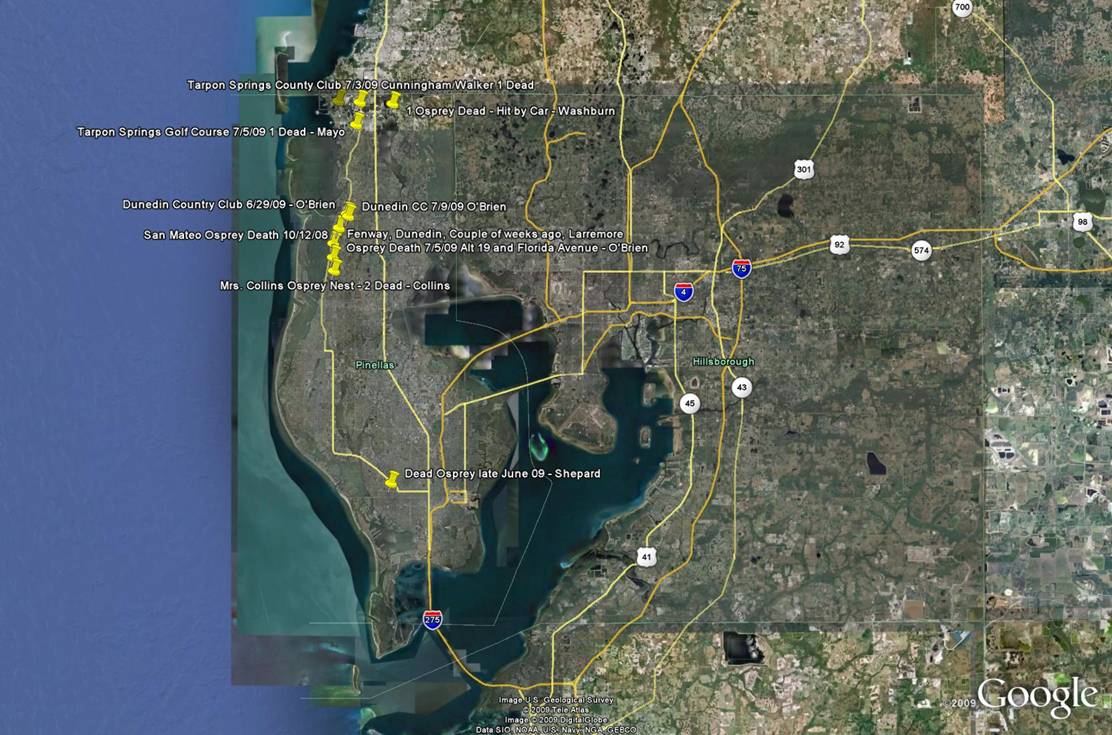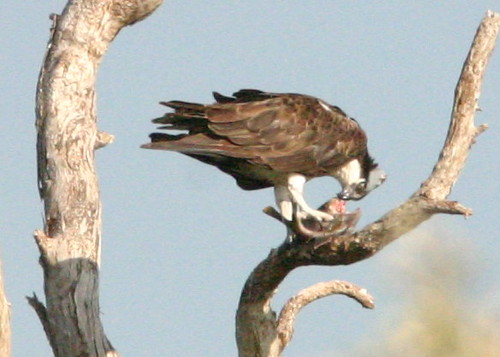Osprey in flight:
In recent weeks, at least eight Ospreys have died along a relatively small stretch of the Florida Gulf coast in Pinellas County near Clearwater. Food for the young appeared to be adequate this spring. According to Barbara Walker, OspreyWatch Program Coordinator from Palm Harbor, these birds have generally done very well. In her estimation, fledglings have been produced in 90% of approximately 30 Osprey nests she has been observing, all in heavily populated areas. Osprey watchers have counted 140 nests in the northern part of the county, of which 90% were on man-made structures such as power poles, cell towers and nest platforms.
Barbara writes: “As far as we know they were all severely emaciated. Some of the locations include Pasadena, Clearwater, Dunedin, and Tarpon Springs. In one instance, on the same property, two Osprey and 1 yard cat perished. The Fish and Wildlife Commission has been contacted in hopes that they will investigate. If anyone can share recent Osprey observations or photographs or has first hand information about a sick or dead Osprey please contact [Barbara] or call 727-431-2856.”
“I think there is something wrong ecologically or environmentally here.One theory was that the water temperature could be too hot and the fish are too deep. Climate change? However I would think the recent rains would have cooled the water somewhat. Anyway, we can’t help but wonder why so many deaths in such a short period of time and I am raising a red flag in this area.”
Most of the dead Ospreys were juveniles. One had been observed catching fish and visiting the nest shortly before its death, and a neighborhood cat also died mysteriously, raising suspicion that some sort of toxicity was involved. Barbara stated that one theory is that as juveniles “they were not highly skilled and were unable to catch any fish in the heavy rains.” However, she noted that the timing of the death of this particular bird “does not coincide with the other recoveries. All of these Osprey are along a specific area of the coast. We have not yet had any reports of Osprey down among other more inland groups such as the Lake Tarpon group or the North Tampa Bay Derby Lanes group to my knowledge although I am sure that more juveniles were treated at Suncoast Seabird Sanctuary that may have come from those areas or areas to the south.”
Barbara related that the Florida Fish and Wildlife Conservation Commission (FWC) is coordinating necropsies for several of the Osprey. “One was done this week. We will have to wait for the results. Comments from rescuers have consistently been that these are the most emaciated Osprey they have seen, just feathers and bone.”
Since ospreys share the top of the fish-eating predator food chain with Bald Eagles and many other herons, gulls and terns, I find this issue, so well described by Barbara, to be a major concern. Perhaps there are particular risks along a small strip of the Pinellas County coastline. We hope the cause of the deaths is determined.
We will be following this issue on our local Pembroke Pines Bald Eagle Watchers FORUM
Here is Barbara Walker’s map, showing the locations of the Osprey deaths:















July 11th, 2009 at 9:01 pm Saturday, July 11 UPDATE:
Today, Barbara Walker reported: “Three more young Osprey perished below their nests in Tarpon Springs, two at one location, and one in another location which we feel there is a reasonable explanation for (2 of the other young survived). On my way to drop off the bodies to FWC yesterday I found a dead Osprey on East Lake Road just south of John Chesnut Park, it was a juvenile. This evening an adult Osprey was killed on 118th Avenue near an area where there was a fish die off which I understand can happen after heavy rains. There were several Osprey in the area and we thought they had probably been attracted by the fish floating on the water. The fish die off and the death of the adult Osprey were reported to FWC.”
Later today, Barb found that the third Osprey had died of trauma. Excerpts of her report: “This evening 7/11/09 a concerned citizen… called me about an injured Osprey… The fish die off was right across the street from that location… [He] said he has been in that area for 16 years and had not noticed anything like this before. A fish die off may have been what attracted quite a few Osprey. One adult Osprey was likely hit by a car and died before I got there. The body is in my freezer [for FWC investigators]… There is obvious trauma. The Osprey was most likely feeding in the area… [The concerned citizen] went through a lot of trouble to get a hold of me and he is asking for an investigation into the fish die off and the stench coming off the property. I did call the Wildlife Alert number between 9:30 and 9:38pm this evening and was told the information would be passed along…”
We flew in from Chicago to Fort Lauderdale this past Tuesday and passed over Tampa-St. Pete coastline. I noted quite a large algae bloom that extended out into the Gulf.. I wonder whether the turbidity of the runoff from heavy rain, along with the cloud cover, deprive the algae of light, and this causes them to deplete the oxygen instead of generating it, suffocating the fish. Of course, the rain may also wash toxic chemicals into the estuary. Will be interested in hearing what the necrocopies may reveal.
Ken